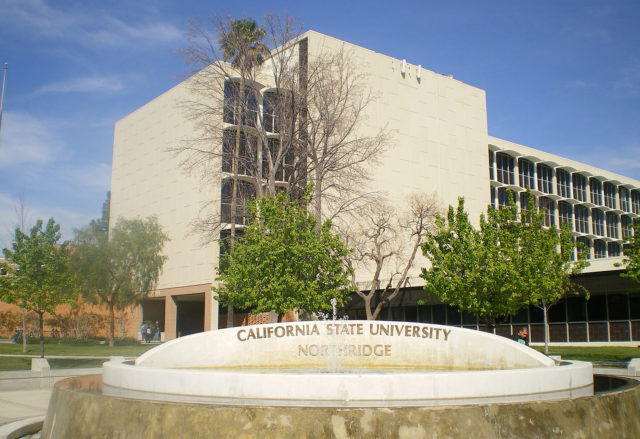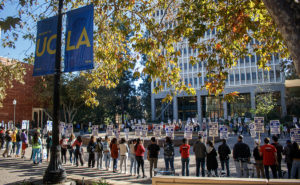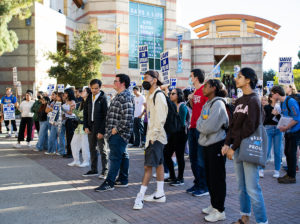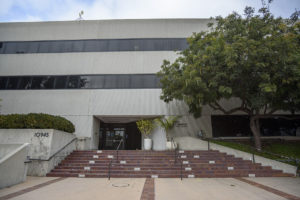UCLA faculty and union leaders discussed the recent California State University faculty strike, which ended Jan. 22 with a new contract.
The California Faculty Association – a labor union representing 29,000 lecturers, professors, counselors, librarians, coaches and other faculty in the CSU – planned a weeklong strike after over half a year of failed negotiations with the CSU to amend previous contracts and raise faculty wages.
On Jan. 22, the first day of spring semester for most CSU campuses, faculty members across all 23 campuses suspended instruction to call for a 12% raise for all university faculty as well as increased parental leave and improved working conditions, according to a CFA press release.
At the end of the strike’s first day, CFA and CSU negotiators reached a tentative agreement, and the strike was called off to resume instruction Jan. 23. The agreement guarantees a 5% general salary increase to last year’s contracts for all faculty, an additional 5% increase this July dependent on government spending and an extension of contract agreements to 2025, according to the press release.
Katie Rodger, president of UC-AFT – a union that represents UC faculty – said while the CSU did not fully meet CFA demands, she believes negotiators ultimately secured a union victory.
“I was really inspired to see that they were getting ready to go out on a sort of statewide, systemwide strike,” Rodger said. “Those that do the negotiating on behalf of their unions are always trying to balance what members are asking for with what they believe are the ultimate gains they can make at the bargaining table.”
Trevor Griffey, a labor studies and history lecturer, was active in CFA from 2015 to 2019 while lecturing at California State University, Long Beach, and California State University, Dominguez Hills. Griffey, who is also the vice president for legislation of UC-AFT, said high levels of inflation and structural problems within the CSU converged to produce the first statewide, all-campus-spanning strike in CSU history.
Generally, tenure-track CSU faculty are expected to teach four classes per semester, but Griffey said many CSU instructors teach five to six classes. Because of the sheer number of students across CSU campuses – about 485,000 – faculty has to accommodate a variety of student needs, inside and outside the classroom.
“The CSU system is, in many ways, the workhorse for providing four-year undergraduate degrees in the state of California,” Griffey said.
Griffey added that the workload for professors and lecturers at these campuses is a serious problem, as it’s not uncommon for 60-person classes to have no reader or graduate teaching assistant to help with student needs.
Griffey and Rodger said they believe the six-week long UC graduate student worker strikes in 2022 and other union action within the UC have raised expectations on what academic union action can accomplish.
“The wave of strikes we’ve seen in the past five years … has been this really important wave of workers who still have unions waking up to the fact that unless they’re willing to strike, they’re not going to be able to stop the big changes that are happening in their profession,” Griffey said.
Workers and unions in academia are in the process of developing constructive strikes, Tobias Higbie, a history and labor studies professor and director of the UCLA Institute for Research on Labor and Employment, said in an emailed statement.
“The settlement after a one day strike points to a changing attitude among union leaders and workers, and the likelihood of more strikes in the future,” Higbie said in the statement. “Over the past five years we’ve seen an uptick in the number of strikes—even before the high profile strikes of ‘labor summer.’”
According to the Los Angeles Times, the term “hot labor summer” is in reference to the recent uptick of labor union action in California, such as the hotel worker strikes and SAG-AFTRA writers strike last year. Over 300,000 workers initiated work stoppages in the state, returning to pre-pandemic levels of union action.
Higbie added in the statement that he believes CSU faculty members effectively leveraged their influence in the statewide university system.
“Workers and unions are now re-learning how to build effective strikes that win big gains,” Higbie said in the statement. “CSU managers likely bet that their faculty would not be able to mount an effective strike because it had been years since the last.”
Griffey said that the CFA is in the process of becoming more rigid in its push to address low wages, high workloads and inequitable structures that union members often face.
Rodger said the CSU faculty strikes and other academic worker actions show a larger, national trend in pursuing better conditions for university faculty.
“Fighting for higher and higher wages is really evidence of the extent to which inflation and other costs have really choked working people in higher ed,” Rodger said. “It made it a necessity that we have to fight for more in order to keep up with rising costs.”





Comments are closed.